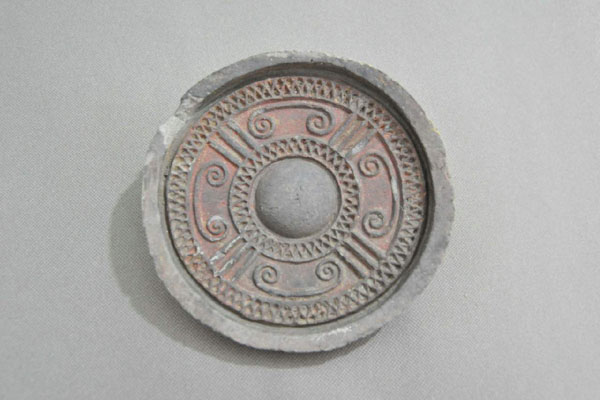 |
|
Visitors admire the stone rhino unearthed near the Tianfu Square in the heart of Chengdu. Photos by Yi Li / For China Daily |
 |
|
The newly excavated relics include an eave tile (above) dating back between the late Eastern Han Dynasty (AD 25-220) and the Three Kingdoms Period (AD 220-280), and a Southern Dynasty (AD 420-589) pottery (below). |
An ancient stone rhino, recently excavated, has drawn scores of people to visit Jinsha Site Museum in Chengdu. Huang Zhiling with more details.
If you are walking on the streets of Chengdu, capital of Sichuan province, chances are you could be stepping on centuries-old treasures buried underneath.
Leaving no stones unturned, the Chengdu Archaeological Institute started archaeological excavations on the site of the Sichuan Grand Theater before constructions begin.
The site is near Tianfu Square in the heart of Chengdu.
Excavation works began in August 2012 and by the end of 2012, archaeologists had excavated an area measuring 4,300 square meters.
They found cultural relics dating back to the Warring States Period (475-221 BC), Han Dynasty (206 BC-AD 220), the Three Kingdoms Period (AD 220-280), Jin Dynasty (AD 265-420), Southern Dynasties (AD 420-589), Sui Dynasty (AD 581-618), Tang Dynasty (AD 618-907), Five Dynasties (AD 907-960), Song Dynasty (960-1279), Yuan Dynasty (1271-1368), Ming Dynasty (1368-1644) and Qing Dynasty (1644-1911).
Among their finds include ash pits, ash ditches, city walls, turrets, drains, houses, wells, building bases and lots of pottery, porcelain, iron and copper wares, coins and building materials such as eave tiles.
|
 |
"The large quantity of exquisite eave tiles provides clues on the whereabouts of the royal palace of the Shu Kingdom in the Three Kingdoms Period," says Yuan Tingdong, an expert on Sichuan history and culture.
Of all the relics, the most conspicuous find is a gigantic stone beast, made from a single piece of red sandstone and looks like a rhino.
It is 3.3 meters long, 1.2 meters wide and 1.7 meters high and weighs about 8.5 tons.
The rhino has a conical head, round body and stubby limbs. Its ears, eyes, mandible and nose are still visible, and so are the patterns of clouds on its body.
"According to the carving style, it might have been made in the period between the State of Qin (9th century BC-221BC) and the Han Dynasty," says Yi Li, who is in charge of the archaeological excavations at the site of Sichuan Grand Theater.
When the stone rhino was found in the pit, it was in a sideway position with its limbs facing outwards, instead of in a standing position.
|
|
|
|
|
|
|
|